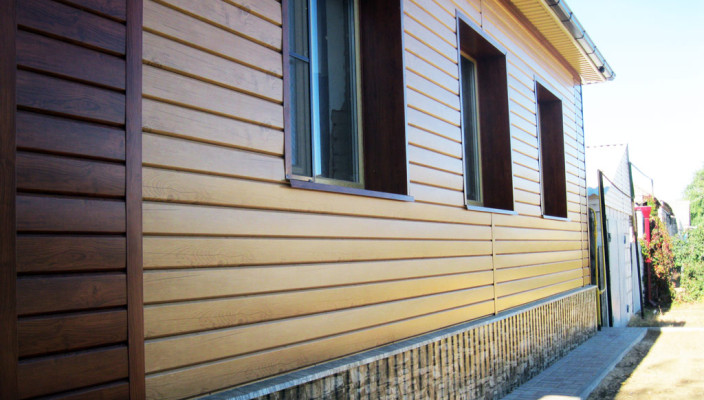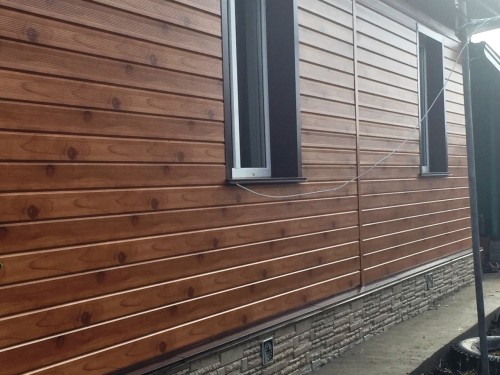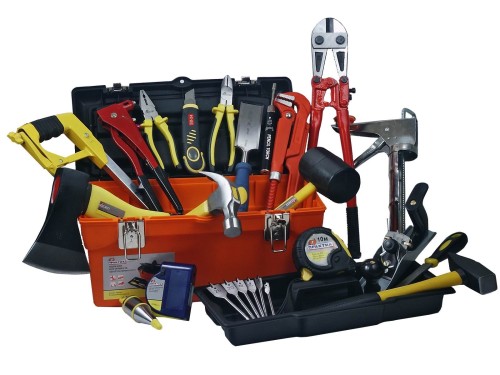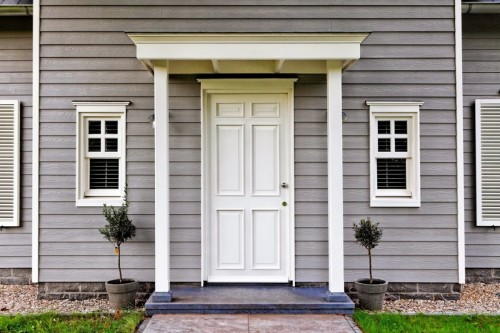Installation of metal panels is simple enough and does not take much time in a person who is accustomed to costing his home alone. Therefore, most owners can and are engaged in self-finishing facades by siding. It seems that no difficulties will cause this business, but it is important to understand the main principles of the implementation of this type of work and the process sequence.
Content
Before choosing siding, you need to explore the properties of different types of this material, all the features of the fasteners and at the same time do not forget about the calculations.
Metal: Material Properties
Such material as a metal siding is a panel for facing facades made from profiled sheets. Its cost is not too large compared to similar materials, and the assembly characteristics are high.
- Its main advantages can be attributed:
- simple installation;
- resistance to frost and other temperature fluctuations;
- resistance to fire;
- durability;
- simple care.
- These characteristics are much higher than the lining or vinyl panels. In terms of aesthetic nature, metal &king analogs does not lift either, because today you can find the trough of such a plan in a variety of color variations.
- To obvious, but not insurmountable minuses include:
- the level of corrosion resistance is not too high, but it is corrected by using corrosion agents;
- sometimes too smooth surface.
- In stores there are panels with a variable length from 300 to 500 cm. In width, you can find panels at 12 - 55 cm. On the one hand, the sheets have a locking type connection, and with the opposite - a special edge that is necessary for fastening it to the building facade .
- You can also purchase various types of slats, corners and other necessary details.
- Wall panels are needed to perform metal rims personally. This processing will give any completion facade design.
Types and features of the use of metal-ham
- The material can be performed in two variations:
- of steel;
- from aluminum.
- The panels of steel are more often used in the construction of private houses. They have sufficient stability, and their weight is quite acceptable for small and unreasted walls.
- The second type is used to finish large industrial buildings. The scope of an aluminum metal riming is so limited due to low strength and high weight of this type of panels.
- Classification for the use of metal:
- base;
- facade panels.
- Metal panels from the second group are very similar to the boards. Facing under the wood transforms the construction, but siding is much cheaper than the array, but looks like a natural tree.
- Separation due to surface type:
- sophytes;
- smooth view panels.
- The first group of materials is better known as perforated panels. They are used to svew out of the cornices. They ensure the ventilating space located under the roof.
- By type editing panels are:
- horizontal;
- vertical.
- Second-type sheets are used by lining of large-scale buildings. For the sheaving of external walls of private houses, metalopannels from the first group are often used.
- Classification in appearance:
- brickwork;
- bar;
- shipboard;
- lining;
- stone;
- log.
- The benefits include the following parameters in private construction.
- reasonable prices for 1 mp;
- uncomplicated installation;
- attractive external design;
- smooth and easy to leaving the surface.
Metal: brave
- Installation of facing metal panels of this species is the most popular area of \u200b\u200bprivate builders. The facade, which is decorated with such a material, from afar looks like a fully made of a wood array. This type of siding sheets has another name - it is metal-hamding Block House.
- Today, manufacturers deliver metal-shaped panels in the shops of various colors. So that the material looked like a wood imitation, specialists apply a special type of processing called Printech. It is based on the same method that is used for offset printing.
- Metal: Block House can be installed not only when cladding bases and facades. Many use this material for the design of the gate or fences. The personnel installation of such steel plants is not complicated. It is made on the basis of a common step-by-step instruction.
Metal hamming bar
- This type of finish today is also very popular. Bar as well as a log, imitates a natural tree. The difference lies only in the cutting and visual appearance of the materials.
- Panels of this type do not harm ecology and are not affected by fire. Therefore, it is often used to finish public buildings.
- Among the main advantages of the panels "under the bar" are particularly distinguished by the fitness for repair, resistance to corrosion and strength with respect to chemical impacts.
- For the manufacture of such panels, several layers of protection are used. Such metalying consists of several layers, among which, zinc, soil and decorative.
- The outer part of the material consists of a polymer coating, on top of which a protective anti-corrosion coating of varnish and paint is applied to the inner side.
Installation of metalyding
- Installation of metal panels is an occupation, from the point of view of work scale, simple. However, the question of the skin still delivers certain difficulties, so the private builder can always hire the team of professionals or to bore the walls of the house on their own.
- Most people prefer to install the metalopannels personally, not to spend funds for installers.
- In such a work, it is important to comply with the sequence and clearly follow the instructions.
Metal: do-it-yourself
One of the most important moments before the start of installation is the measurement of the amount of material. This fact is often one of the main allowed errors.
In the calculation you need to take the area of \u200b\u200ball walls, while not taking into account the size of the sizes after the frame has already been created. To properly determine the quantity, you need to simulate the area of \u200b\u200bcladding on the house, divide everything to the width of one piece of siding and be sure to add 10% - 20% for shifts and errors on each side.
Many manufacturers can provide their customers with individual panels manufactured by the desired parameters of the walls of the house. In this case, waste is quite small, and the installation will be noticeably simplified.
Required tools
- Selfless.
- Roulette.
- Metal and additional items to them.
- Brackets.
- Scissors for metal.
- P-profile.
- Screwdriver.
- Nails type dowel.
- Perforator.
- Building level.
Start: Installation Tips for Metal Handing
- Before mounting the crates, you need to remove the plaster if it crepts and eliminate the walls of the walls and corners.
- In the manufacture of the crates, it is better to use a metal profile. The tree in this case is not too reliable material for the future frame.
- The shell step should not be more than 40 cm, but in the location of windows and doors you need to install a solid frame.
- Plates for insulation should fit tightly, but you need to follow, so that their surface is not deformed when joints with each other.
- The window and door framing should begin with the installation of the upper elements, and then the side. It is necessary to provide for window sills.
- When laying metal plates in length, the necessary strips are superimposed. Longer sheets are fastened from the center and further consistently at the edges.
Metal finishing sequence
Equipment of the material is designed for simple installation due to standard mounts, so observing the sequence of sheets and clarity of the joints, you can easily strip the desired area without difficulty.
- The foundation of the wall must be thoroughly prepared before installing the metal. All surfaces with bulk coatings must be cleaned and strengthened. Mandatory processing against fungus. Walls are aligned and only accurate measurements of the required parameters are performed at this stage, the estimate is considered.
- Then there is a phased installation of the crate. First, the brackets are mounted with nails dowel and screws.
- If you need additional insulation of the house, installing special plates holding the heat. They fit into all shelling gaps and firmly seal joints. This allows you to prevent the appearance of cold bridges between the wall surface and the facing material.
- In the event that the material selected for insulation is a foam, it is not necessary to worry about creating an additional layer of protection. It does not rot and is not exposed to moisture. If wool acts as thermal insulation material, then another layer of protection will be required - the parobaric membrane. In this case, you need to remember the gap of 2 cm between the metal plants and the thermal insulation layer. The heat insulator must be attached to the wall using anchors. They reliably fix almost any material.
- The installed insulation is covered with a film for waterproofing.
- Then with the help of self-tapping screws or rivets, the details of the crates are attached to the brackets, and the installation of all other components of the metal-rope boards are installed, which are attached directly to the framework itself.
- Docking the parts of the door and the window frame is made at an angle of 45 C. In this case, the elements must overlap each other. You also need to pay attention to the density of the connections, each element should touch the adjacent one. It is impossible to allow free moves of details. Because of this, vibrations and rattling of the facade are possible during wind loads.
- The ray step needs to be selected, based on the requirements of the manufacturer of the metallopannels. Most often it is 30 - 40 cm. The mounting frequency is the same. With low walls and minimum cutting of the brackets, you can slightly reduce their quantity, but savings on this type of fasteners are not the best option, since it is this docking that performs the most important function - attaches the mounted facade.
- Next, proceed to step by step horizontal installation of the metallopannels. We start with the starting strip mount. To do this, the layout of the plan is made, according to which the first plank is installed, to which the next sheet is then fastened. In case the walls have an impressive height, and the lengths of the panels are not enough, then a special mounting for docking two sheets is performed.
- The next step is framed the doors and windows with planks.
- We close the joints with special angular elements. They have the kind of dimensional pieces of 2 m.p. It is important to observe perpendicular compounds and parallel locations of all planes of each of the elements.
- Then proceed to the installation of all other bands using self-tapping screws. In the event that the area of \u200b\u200bthe facade of non-standard form and size or during installation, difficulties appeared in the docking, then additional cutting sheets are performed. Metal profiles are cut or special scissors or a grinder.
- Now proceed to fixation. Fixing all panels should occur in two stages. First you need to lachel the lock device with the first profile, and then with the help of screws to attach to the frame. To do this, there are special holes on the profile.
- When most of the case is already made, proceed with the installation of the finishing band using a special fastener - a corner or top-end.
Note: During the installation of metallosoiding in a private house, it is not necessary to make a gap when tightening the screws. This is due to the small coefficient of the expansion of the metal at a certain temperature.
It is also important to take into account the installation of seals. They are installed in the grooves of additional details. For this, bilateral scotch is used, and the fixation occurs due to the presser power of the panels themselves. Seals reduce possible vibrations of facades, and also do not allow water to fall under siding and protect it from wind exposure.
In the markets with construction materials, organizations recently began to appear, which offer their clients the installation of turnkey facades. They are dealt with by calculation, buy all the necessary materials, make the installation of the very facade and its insulation, clearly following all customer requirements. The cost of installing metal metal plates is quite affordable and ranges from 1 100 p. and up to 1800 p. for 1 m square. Coatings. The exact amount will also depend on the complexity of the work performed and the design of the facade. Of course, if you deal with the facade of the facade itself, then the cost will be much smaller, because only consumables will include.
Metal and robes is quite convenient and practical material, the cost of which is not too high. The use of such panels will help not face "wet" building operations and make a fine facade with your own hands for a fairly short time.

























